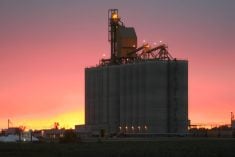I believe all is getting better in the beef world, but may not be perfect yet. I understand the XL Beef plant at Brooks, Alta is nearly firing on all cylinders, although Jerry Klassen in his marketing column on page 40 says as of late November, the slaughter pace was still a bit behind the pre meat-recall days of September.
I had a couple more comments from blog readers, see below, and as you read on, the Western Stock Growers Association, backed by the Fort Macleod-area zone of the Alberta Beef Producers is calling for a federal investigation.
Read Also

Cancer agency reclassifies another herbicide ‘probably carcinogenic’
The WHO’s cancer research agency has now put atrazine, a herbicide well known to corn growers, in the same potential-hazard category where the agency put glyphosate.
This meat recall was such a major screw-up, with all kinds of finger pointing, I believe an investigation would be a good thing.
Here are some comments from two of my blog readers:
G. Johnston of Saskatchewan writes: “Just a reminder that there is a processing plant in Moose Jaw. Nilsson Brothers bought it and promptly closed it causing all beef to slaughter to have to be shipped to Alberta. It is my understanding that this plant has been put back into production for a few days every year so that it doesn’t lose its licence to operate. If that is actually the case, it could be fired up fairly quickly, one would expect. If XL is going to change hands as has been suggested perhaps selling the Moose Jaw plant should be one of the stipulations of the deal so that it could be reopened and used in this province.”
Pat Gauthier writes: “Forgive my ignorance. Maybe I should Google information on E. coli before I make any comments, but I don’t have time. I’m busy with discing and plowing and feeding and getting ready to buy calves and so and so on.
I was told by a vet that E. coli is everywhere in the barnyard and when we are processing cattle and get a little fresh manure in the mouth because we are yelling above the bawling to communicate that we are definitely exposed to it. We are producers and country people so we have a built-in immunity to it. Have you ever heard of the 4H kid that gets sick? Well! My husband eats well-done steak and I eat med-rare. I say to people if you are worried that you will get E. coli from your med-rare steak then cook it better. I won’t, but you who are never exposed to countryside bacteria should cook it better. I say as people get further and further anyway from germs and bacteria, they get sick easier. Maybe the general public shouldn’t wash so much and don’t be afraid to get back to the land. My opinion of the CFIA, is that they have way too much power and it’s going to their heads. If you read between the lines there is politics with this whole fiasco.”
If you are ever looking for this mysterious blog, go online to www.grainews.ca and you’ll find it there.
It pays to ask directions
Did you hear about the bagpiper from Brandon, Manitoba who was asked to play at the graveside funeral service for this old bachelor farmer being buried in rural community cemetery?
The piper was running late, and being like most men he didn’t want to stop and ask for help with directions.
Although an hour late, he finally found a group of workers out in the country around a grave. The piper figured the undertaker, hearse, and any friends had already come and gone. Feeling badly, and still wanting this old farmer to have a fitting send off, he apologized to the men around the hole for being late, he went to the graveside and looked down and the vault lid was already in place. Not knowing what else to do, he began to play. The workers put down their lunches and began to gather around. The piper played out his heart and soul for this man with no family and friends. As he played “Amazing Grace,” the workers began to weep. They wept, the piper wept, everyone wept together. When finished the piper quietly packed his gear in his car, about to leave with pride that he had done his best. But, that warm feeling soon vanished. Just as he opened the car door he heard one of the somber workers say, “I never seen nothin’ like that before and I’ve been putting in septic tanks for 20 years.”
WSGA calls for inquiry
The Western Stock Growers Association, also supported by a zone resolution from the Alberta Beef Producers, is calling on the federal government to conduct an independent investigation into what happened in that whole recall mess at the XL Beef plant at Brooks.
The WSGA has submitted a brief to Agriculture Minister Gerry Ritz calling for the inquiry, says Phil Rowland, WSGA president. Rowland and the WSGA makes the point that it is pretty hard to make a reasonable plan for the future, unless you properly understand what happened in the past.
“The roles of all involved including the operator, the CFIA, the USDA and governments must be explored. Everyone from the cattle producer to the consumer holds a measure of responsibility to keep the food on our families’ plates safe,” says Rowland. “We applaud the ABP for joining our efforts in requesting a full investigation into the recall.”
The WSGA has some pretty specific unanswered questions it would like addressed in the investigation:
1. When an outside audit conducted in May by Silliker Inc. found that sampling of trim product was “inconsistent” with the standard, why was not a Corrective Action Request (CAR) issued?
2. When a 2010 survey by FSIS indicated that the majority of the largest meat packers diverted or destroyed all trim in a batch or on a day if five per cent of its tests were positive for E. coli 0157:H7 and the HACCP plan for XL only diverted product if more than 10 per cent of a batch tested positive or more than 20 per cent of the days production was tainted, why did the CFIA approve this process?
3. Between Sept. 17 and Oct. 12, CFIA issued 17 Health Hazard Alert updates, each of which has expanded the list of recalled products in excess of 1800 products and an estimated recall of 45 million pounds. What parameters did CFIA use in making these decisions?
4. As 17 Health Hazard Alerts is very high considering it was for the same event, did the CFIA give any thought or regard for the damage to the reputation of the beef industry?
5. Of the recalled shipments of beef, how many tests were positive for E. coli 0157:H7?
6. Is it unusual to recall whole muscle cuts and why was it deemed necessary in this situation?
7. Why did the CFIA not think it would be useful to require companies to analyze test results for the potentially fatal E. coli 0157:H7?
9. The Canadian Traceability System is comprised of two components that being on the live side with the Canadian Cattle Identification Agency (CCIA) and on the processed side with Canadian Food Product Traceability (CFPT). Why is the CCIA mandatory and punishable by fines whereas the CFPT is voluntary and participation is much lower with no consequences of non-compliance?
“It would be a shame to throw lives and businesses in jeopardy without learning the exact cause of the crisis,” says Rowland. “And we won’t know the answer to this unless there is an independent investigation.”
You can learn more about the request for an investigation on the WSGA website at: www.wsga.ca
Beef school online
Through a partnership with RealAgriculture.com, the Beef Cattle Research Council (BCRC) has launched a new online learning resource called Beef Research School for the benefit of Canadian beef cattle producers. The school, a series of approximately 30 videos, will encourage producers to utilize research-supported knowledge and technologies, which can positively impact their herds, land and bottom lines, and support the competitiveness and sustainability of the industry.
Videos will feature interviews with researchers, veterinarians and other industry experts from across Canada on the latest research knowledge and technology, as well as progressive producers and feedlots that put it into practical use on their operations. Each segment will run approximately six to 10 minutes.
“Producers have demonstrated that they are keen to learn and will quickly adopt new research-supported ideas when it makes sense for their operation,” says Matt Bowman, chair of the BCRC and a producer from Thornloe, Ontario. “Given the range of research topics of interest to producers, it can be difficult for them to stay caught up on publications or attend numerous seminars and field days, so the videos will be an engaging, convenient way to learn about the latest innovations.”
Topics presented by the videos will include research knowledge related to animal health and welfare, feeds, food safety, beef quality, genetics and environmental stewardship. The series will also discuss the importance and value of research in the Canadian beef cattle industry, showcase a research centre and highlight extension resources available across the country. Videos in the School will continue to be filmed and distributed through to Summer 2013.
The Beef Research School can be found online at www.BeefResearch.ca. †















